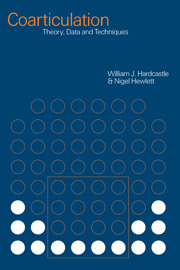Book contents
- Frontmatter
- Contents
- List of figures
- List of tables
- List of contributors
- Acknowledgments
- Introduction
- Part I Theories and models
- Part II Research results: components of the motor system for speech
- Part III Wider perspectives
- Part IV Instrumental techniques
- 10 Palatography
- 11 Imaging techniques
- 12 Electromagnetic articulography
- 13 Electromyography
- 14 Transducers for investigating velopharyngeal function
- 15 Techniques for investigating laryngeal articulation
- 16 Acoustic analysis
- References
- Index
15 - Techniques for investigating laryngeal articulation
Published online by Cambridge University Press: 22 September 2009
- Frontmatter
- Contents
- List of figures
- List of tables
- List of contributors
- Acknowledgments
- Introduction
- Part I Theories and models
- Part II Research results: components of the motor system for speech
- Part III Wider perspectives
- Part IV Instrumental techniques
- 10 Palatography
- 11 Imaging techniques
- 12 Electromagnetic articulography
- 13 Electromyography
- 14 Transducers for investigating velopharyngeal function
- 15 Techniques for investigating laryngeal articulation
- 16 Acoustic analysis
- References
- Index
Summary
Introduction
In this discussion we will deal with techniques which permit investigation of two rather different aspects of laryngeal behaviour. Philip Hoole deals with the articulatory aspect in Section A and this specifically concerns those laryngeal adjustments of abduction and adduction involved in the production of voiceless segments, and which can conveniently be referred to by the term ‘devoicing gesture’. This section will accordingly look mainly at techniques for assessing the kinematics of this gesture.
Christer Gobl and Ailbhe Ní Chasaide deal with the second aspect which concerns the detailed acoustic analysis of phonation itself. A number of studies in recent years have highlighted the fact that even during what would be termed modal phonation there is considerable modulation of the voice source as a function of the prosodic and segmental content of utterances. Of particular interest here are exploratory studies which indicate that the phonatory quality of a voiced segment may be affected by laryngeal adjustments associated with an adjacent voiceless consonant, and which suggest that there may be striking cross-language differences. These phonatory variations may yield valuable insights into the nature and timing of laryngeal gestures associated with these segments. Section B of this chapter provides a brief outline of the techniques that may be used to analyse the voice source, concentrating especially on those used to obtain the data presented in chapter 5.
- Type
- Chapter
- Information
- CoarticulationTheory, Data and Techniques, pp. 294 - 321Publisher: Cambridge University PressPrint publication year: 1999
- 1
- Cited by



